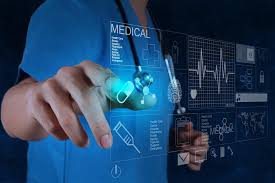
Information Technology in Health: Accelerating Medical Innovation
nformation Technology in Health: Accelerating Medical Innovation
Information technology has brought about major changes in various fields, and the healthcare sector is no exception. Innovations in medical technology have become a major catalyst in accelerating the development of healthcare, improving the efficiency and quality of medical services. In this article, we will discuss various examples of technology in the healthcare sector that have had a significant impact on medical progress.
10 Latest Medical Technology Innovations: The Future of Healthcare
Technological innovation has provided many solutions to health challenges around the world. From artificial intelligence to nanotechnology, here are ten examples of rapidly emerging health innovations that are expected to change the future of healthcare.
1. Use of Artificial Intelligence (AI) in Medical Diagnosis
Artificial Intelligence (AI) is one of the most promising innovations in healthcare. This technology is used to help doctors diagnose diseases more quickly and accurately. AI is able to process large amounts of medical data and analyze it to find patterns that may be difficult for humans to detect. For example, AI has been used to detect breast cancer, analyze radiological images, and predict the likelihood of disease based on a patient’s medical history.
With AI , doctors can reduce misdiagnosis and provide more appropriate care. In addition, AI also allows the healthcare system to be more efficient in treating more patients with fewer resources.
2. Robotics in Surgery
Robotics has opened a new era in surgical operations by providing precision that is unattainable by human hands. Robotic surgical systems allow surgeons to perform highly complex procedures more safely and with minimal risk. One of the most famous examples is the da Vinci system , which allows surgeons to control a robotic arm to perform operations with high accuracy.
Robotics in medicine also helps in reducing patient recovery time, as these procedures are generally less invasive than traditional surgeries. In addition, robotic surgery allows doctors to perform operations remotely, which can significantly expand access to care in remote areas.
3. Telemedicine and Remote Consultation
Telemedicine has become an important solution, especially during the COVID-19 pandemic. With this technology, patients can consult with doctors without having to come to the hospital. Telemedicine allows remote medical consultations using video calls, applications, or other online platforms.
The main advantages of telemedicine are convenience for patients, as well as reduced travel time and costs. In addition, this technology can also bridge into health services, especially in rural areas or areas with limited access to health care.
4. Nanotechnology in Medicine
Nanotechnology is one of the most revolutionary innovations in healthcare. Using nano-sized particles, scientists can create more effective and targeted drugs . The most significant example of nanotechnology application is in cancer treatment, where nanoparticles can be directed directly to cancer cells without damaging the surrounding healthy tissue.
In addition, nanotechnology is also used in the development of more sensitive and accurate diagnostic tools . The ability to work at the molecular level makes nanotechnology the future of high-precision medicine.
5. Electronic and Bioelectronic Implants
Electronic and bioelectronic implants are medical devices that are implanted in the body to monitor or regulate biological functions. One well-known example is the pacemaker , a device that helps regulate the heartbeat. Other electronic implants include cochlear hearing aids for people with hearing loss and neurostimulators that help manage chronic pain.
This implant technology allows patients to live a normal life with the support of technology. In the future, developments in this field could create smarter and more autonomous devices for various medical applications.
6. Use of Big Data in Healthcare
Big Data has become a critical element in modern healthcare management. Data generated from electronic medical records (EMRs), wearable health devices, and genetic data have provided opportunities to analyze health trends and improve treatment outcomes. Big data analytics helps hospitals and healthcare providers identify health risks early, personalize care, and optimize clinical operations.
The use of big data is also very important in clinical research, where researchers can use large-scale data to discover new treatments and improve understanding of certain diseases.
The Future of Healthcare
Technological innovation in healthcare continues to advance rapidly, and the future of healthcare looks set to become increasingly digital and personalized. With technologies like AI , robotics, big data , and nanotechnology , we can expect treatments to become more efficient, precise, and affordable. These innovations will not only improve health outcomes, but also expand access to healthcare for people who are struggling to get it.
Technological Innovation in Improving Access to Health Services in Rural Areas
One of the biggest efforts in the global health system is to ensure that people in rural areas have adequate access to health services. Technology has offered a variety of solutions to address this issue. Telemedicine , for example, allows doctors to provide consultations and diagnoses to patients in remote areas without having to meet face-to-face.
Additionally, innovations in portable diagnostic technology and more affordable medical devices have made it possible to diagnose and treat patients in locations far from healthcare facilities. For example, portable ultrasound devices have made it possible to conduct health checks in places that were previously difficult to reach.
Author: Faris Hadinata – Directorate of Information Technology Center

